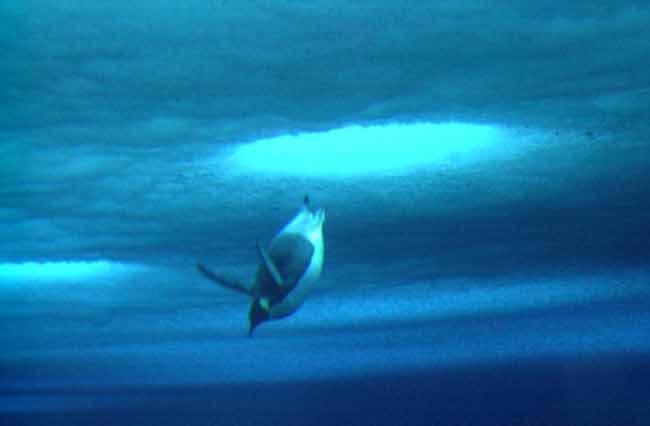Scientists Puzzled by Extreme Penguin Dives

When emperor penguins dive below the Antarctic sea ice in search of food, they can descend five times as deep as a human and can swim on a single breath for up to 20 minutes. Researchers are trying to find out how they manage these incredible feats to potentially help improve surgical procedures and anesthesia.
Emperor penguins are the tallest and heaviest species of penguin. During their harsh life cycle [graphic] they dwell on ice and march up to 100 miles from their mating grounds to dive [image] into frigid waters to feed on krill and fish.
Using small devices called time-depth recorders, researchers found that the birds could dive deeper than 1,800 feet—the deepest a human can dive unassisted is just over 300 feet [graphic].
Video: Living With Penguins
The penguins "dove much deeper than we ever thought they would,” said Paul Ponganis, a physiologist at the Scripps Institute of Oceanography.
Researchers aren’t sure how emperors can descend so deep without developing decompression sickness, or the bends. “That’s probably the big question about tolerating depth,” Ponganis told LiveScience.
The bends is a condition that occurs in human divers in which under high pressure nitrogen builds up in the blood as it exchanges gas with the lungs, and that nitrogen is released as bubbles during ascent, causing itching, pain, and sometimes death. Whales hold the deep-diving record for air-breathers, but they do get the bends, too.
Sign up for the Live Science daily newsletter now
Get the world’s most fascinating discoveries delivered straight to your inbox.
Seals, which can dive even deeper than the emperors, avoid this condition because they deflate their lungs when they go down. Ponganis said it is unlikely that emperors do this because they structure of their lungs is different.
Cool Question: Why Don't Penguin Feet Freeze on Ice?
Ponganis is also looking at how emperors can stay under water for such a long time on a single breath of air. “They can swim and dive and function quite well when the oxygen level goes very, very low in the lungs,” Ponganis said. At the same oxygen levels, a human would go unconscious.
Compared with humans, both seals and emperors have more oxygen circulating in their blood because they have a higher blood volume and more hemoglobin, the protein that carries oxygen through the blood. The penguins also have more myoglobin, which stores oxygen in muscle, in their bodies.
“When they’re swimming, they have an oxygen store right there that they can use,” Ponganis said.
And unlike humans, emperors decrease their heart rate when they swim, so they use up their stores of oxygen slower.
Ponganis is interested in how penguin physiology compensates in these conditions because it could improve anesthesia techniques and aide in research of how to avoid tissue damage when the body is deprived of oxygen.
- Image: Penguin Shuffle
- Mating March of the Penguin Slows Down
- Study: Penguin, Seal Food Source Shrinks
- Video: Living With Penguins
- All About Penguins

Andrea Thompson is an associate editor at Scientific American, where she covers sustainability, energy and the environment. Prior to that, she was a senior writer covering climate science at Climate Central and a reporter and editor at Live Science, where she primarily covered Earth science and the environment. She holds a graduate degree in science health and environmental reporting from New York University, as well as a bachelor of science and and masters of science in atmospheric chemistry from the Georgia Institute of Technology.










